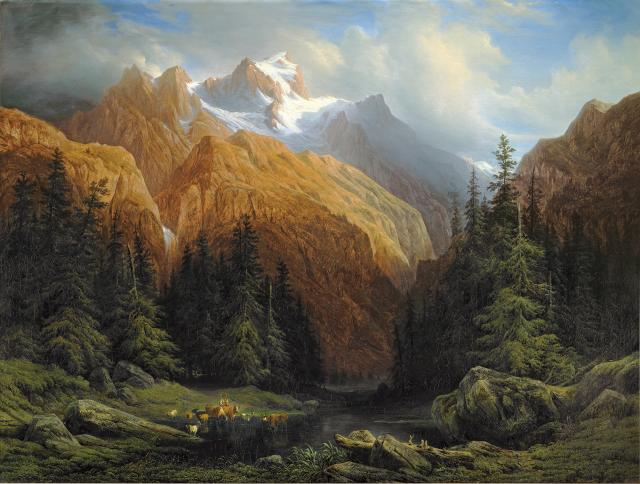Nine years before his student Alexandre Calame paints Souvenir de Rosenlaui (Souvenir of Rosenlaui – Collection Pictet), François Diday executes this magnificent large-scale picture depicting – from another point of view – the same region dominated by the imposing Wellhorn and Wetterhorn mountains. Diday is fascinated by the latter peak, so much so that he will portray it a dozen times over the course of his career.
The year this canvas is painted, 1844, sees the artist awarded the Gold Medal by the Canton of Bern: “The distinctions that your talent has garnered abroad have not weakened in you your interest in the modest efforts of Switzerland, our homeland, to advance the arts… With infinite pleasure we take this opportunity to present to you a token of our appreciation of your remarkable talent, and we are convinced that the enclosed medal will have, in your view, the chief merit of being awarded to you by an authority of our homeland.”
With meticulous care lavished on the details here, Diday devotes practically the whole of the pictorial space to the mountains in this composition. Before their grandeur, the human figures and animals in the foreground are reduced to a tiny size, their presence inescapably establishing the scale of this majestic setting. From the white peaks snow turns into water and a waterfall pours down between the two masses of rock on the left. This motif is often selected as the main subject in Diday’s work. It is a characteristic element of the picturesque Swiss landscape, symbolising both water as a source of life and the destructive power of nature. Thus, behind a scenic appearance, the painting describes a landscape that oscillates between Arcadian charm and an unsettling power. Diday’s realism expresses here in a typically romantic spirit the uncanny feeling provoked by a nature that is hostile to man.
The year this canvas is painted, 1844, sees the artist awarded the Gold Medal by the Canton of Bern: “The distinctions that your talent has garnered abroad have not weakened in you your interest in the modest efforts of Switzerland, our homeland, to advance the arts… With infinite pleasure we take this opportunity to present to you a token of our appreciation of your remarkable talent, and we are convinced that the enclosed medal will have, in your view, the chief merit of being awarded to you by an authority of our homeland.”
With meticulous care lavished on the details here, Diday devotes practically the whole of the pictorial space to the mountains in this composition. Before their grandeur, the human figures and animals in the foreground are reduced to a tiny size, their presence inescapably establishing the scale of this majestic setting. From the white peaks snow turns into water and a waterfall pours down between the two masses of rock on the left. This motif is often selected as the main subject in Diday’s work. It is a characteristic element of the picturesque Swiss landscape, symbolising both water as a source of life and the destructive power of nature. Thus, behind a scenic appearance, the painting describes a landscape that oscillates between Arcadian charm and an unsettling power. Diday’s realism expresses here in a typically romantic spirit the uncanny feeling provoked by a nature that is hostile to man.
